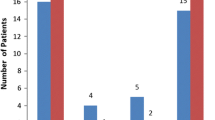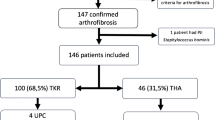Abstract
Data demonstrating that antibiotics administered intraoperatively in patients with surgical revision for periprosthetic joint infection achieve concentrations exceeding minimal inhibitory concentrations of the identified bacteria at the surgical site when the new implant is inserted are lacking. We prospectively included patients with periprosthetic joint infection operated with one- or two-stage replacement during which cefepime (2g)-daptomycin (10mg/kg) combination was administered intravenously as intraoperative empirical antibiotic treatment. Three biopsies (two bones and one synovial membrane) were taken from each patient just before the insertion of the new implant. Eighteen adults of median age 68 years were included. Knee was involved in 10 patients (55.6%) and surgery consisted in one-/two-stage replacement in 11/7 patients. A tourniquet was used during the intervention in the 10 patients with knee prosthesis. Among 54 tissue samples, cefepime and daptomycin were detected respectively in 35 (64.8%) and 21 (38.9%) cases (P=0.01). A total of 17 bacteria dominated by staphylococci (n=14) were identified in 10 patients; tissue inhibitory quotient calculated in 51 samples was >1 in 22 cases (43.1%) for cefepime and in 16 cases (31.4%) for daptomycin. The proportion of tissue samples with detectable antibiotic was significantly higher in hip versus knee prosthesis (P=0.03). The present study suggests that intraoperative empirical administration of cefepime-daptomycin combination during septic prosthetic joint replacement results in a high proportion of tissue samples in which at least one of the two antibiotics was not detected or at a low concentration despite satisfactory concomitant blood serum concentrations.


Similar content being viewed by others
References
Moran E, Masters S, Berendt AR, McLardy-Smith P, Byren I, Atkins BL (2007) Guiding empirical antibiotic therapy in orthopaedics: the microbiology of prosthetic joint infection managed by debridement, irrigation and prosthesis retention. J Infect 55:1–7. https://doi.org/10.1016/j.jinf.2007.01.007
Lora-Tamayo J, Murillo O, Iribarren JA, Soriano A, Sánchez-Somolinos M, Baraia-Etxaburu JM et al (2013) REIPI Group for the Study of Prosthetic Infection. A large multicenter study of methicillin-susceptible and methicillin-resistant Staphylococcus aureus prosthetic joint infections managed with implant retention. Clin Infect Dis 56:182–194. https://doi.org/10.1093/cid/cis746
Waldvogel FA, Vaudaux PE, Pittet D, Lew PD (1991) Perioperative antibiotic prophylaxis of wound and foreign body infections: microbial factors affecting efficacy. Rev Infect Dis 13(Suppl 10):S782–S789. https://doi.org/10.1093/clinids/13.supplement_10.s782
Tshefu K, Zimmerli W, Waldvogel FA (1983) Short-term administration of rifampin in the prevention or eradication of infection due to foreign bodies. Rev Infect Dis 5(Suppl 3):S474–S480. https://doi.org/10.1093/clinids/5.supplement_3.s474
Bouchenaki N, Vaudaux PE, Huggler E, Waldvogel FA, Lew DP (1990) Successful single-dose prophylaxis of Staphylococcus aureus foreign body infections in guinea pigs by fleroxacin. Antimicrob Agents Chemother 34:21–24. https://doi.org/10.1128/aac.34.1.21
Zimmerli W, Waldvogel FA, Vaudaux P, Nydegger UE (1982) Pathogenesis of foreign body infection: description and characteristics of an animal model. J Infect Dis 146:487–497. https://doi.org/10.1093/infdis/146.4.487
Miles AA (1956) Nonspecific defense reactions in bacterial infections. Ann N Y Acad Sci 66:356–369. https://doi.org/10.1111/j.1749-6632.1956.tb40141
Rodriguez-Merchan EC (2018) Preoperative aspiration culture (PAC) for the diagnosis of infection in a prosthetic knee joint. Arch Bone Joint Surg 6:342–345
Osmon DR, Berbari EF, Berendt AR, Lew D, Zimmerli W, Steckelberg JM et al (2013) Infectious Diseases Society of America. Diagnosis and management of prosthetic joint infection: clinical practice guidelines by the Infectious Diseases Society of America. Clin Infect Dis 56:e1–e25. https://doi.org/10.1093/cid/cis803
Esposito S, Leone S, Bassetti M, Borrè S, Leoncini F, Meani E et al (2009) Bone Joint Infections Committee for the Italian Society of Infectious Tropical Diseases (SIMIT). Italian guidelines for the diagnosis and infectious disease management of osteomyelitis and prosthetic joint infections in adults. Infection 37:478–496. https://doi.org/10.1179/1973947815Y.0000000012
Ariza J, Cobo J, Baraia-Etxaburu J, Benito N, Bori G, Cabo J et al (2017) Spanish Network for the Study of Infectious Diseases and the Sociedad Española de Enfermedades Infecciosas; Microbiología Clínica (SEIMC). Executive summary of management of prosthetic joint infections. Clinical practice guidelines by the Spanish Society of Infectious Diseases and Clinical Microbiology (SEIMC). Enferm Infect Microbiol Clin 35:189–195. https://doi.org/10.1016/j.eimc.2016.08.012
Deroche L, Plouzeau C, Bémer P, Tandé D, Valentin AS, Jolivet-Gougeon A et al (2019) and the CRIOGO (Centre de Référence des Infections Ostéo-articulaires du Grand Ouest) Study Group. Probabilistic chemotherapy in knee and hip replacement infection: the place of linezolid. Eur J Clin Microbiol Infect Dis 38:1659–1663. https://doi.org/10.1007/s10096-019-03594-z
Endimiani A, Perez F, Bonomo RA (2008) Cefepime: a reappraisal in an era of increasing antimicrobial resistance. Expert Rev Anti-Infect Ther 6:805–824. https://doi.org/10.1586/14787210.6.6.805
Senneville E, Caillon J, Calvet B, Jehl F (2016) Towards a definition of daptomycin optimal dose: lessons learned from experimental and clinical data. Int J Antimicrob Agents 47:12–19. https://doi.org/10.1016/j.ijantimicag.2015.11.005
Joseph C, Robineau O, Titecat M, Putman S, Blondiaux N, Loiez C et al (2019) Daptomycin versus vancomycin as post-operative empirical antibiotic treatment for prosthetic joint infections: a case-control study. J Bone Joint Infect 4:72–75. https://doi.org/10.7150/jbji.22118
John AK, Baldoni D, Haschke M, Rentsch K, Schaerli P, Zimmerli W et al (2009) Efficacy of daptomycin in implant-associated infection due to methicillin-resistant Staphylococcus aureus: importance of combination with rifampin. Antimicrob Agents Chemother 53:271–2724. https://doi.org/10.1128/AAC.00047-09
Puhto AP, Puhto T, Niinimäki T, Ohtonen P, Leppilahti J, Syrjälä H (2015) Predictors of treatment outcome in prosthetic joint infections treated with prosthesis retention. Int Orthop 39:1785–1791. https://doi.org/10.1007/s00264-015-2819-2
Senneville E, Joulie D, Legout L, Valette M, Dezèque H, Beltrand E, Roselé B, d’Escrivan T, Loïez C, Caillaux M, Yazdanpanah Y, Maynou C, Migaud H (2011) Outcome and predictors of treatment failure in total hip/knee prosthetic joint infections due to Staphylococcus aureus. Clin Infect Dis 53:334–340. https://doi.org/10.1093/cid/cir402
Lefèvre S, Saleh M, Marcellin L, Subilia A, Bourcier T, Prévost G, Jehl F (2012) Daptomycin versus vancomycin in a methicillin-resistant Staphylococcus aureus endophthalmitis rabbit model: bactericidal effect, safety, and ocular pharmacokinetics. Antimicrob Agents Chemother 56:2485–2492. https://doi.org/10.1128/AAC.05745-11
Elkhaïli H, Linger L, Monteil H, Jehl F (1997) High-performance liquid chromatographic assay for cefepime in serum. J Chromatogr B Biomed Sci Appl 690:181–188. https://doi.org/10.1016/s0378-4347(96)00406-9
Jehl F, Gallion C, Monteil H (1990) High-performance liquid chromatography of antibiotics. J Chromatogr 531:509–548. https://doi.org/10.1016/s0378-4347(00)82293-8
Levêque D, Gallion-Renault C, Monteil H, Jehl F (1998) Analysis of recent antimicrobial agents in human biological fluids by high-performance liquid chromatography. J Chromatogr A 815:163–172. https://doi.org/10.1016/s0021-9673(98)00452-x
Cameron JR, Skofronick JG, Grant RM (1999) Physics of the body. Medical Physics Publishing Corporation, Madison
Bedenčič K, Kavčič M, Faganeli N, Mihalič R, Mavčič B, Dolenc J, Bajc Z, Trebše R (2016) Does preoperative antimicrobial prophylaxis influence the diagnostic potential of periprosthetic tissues in hip or knee infections? Clin Orthop Relat Res 474:258–264. https://doi.org/10.1007/s11999-015-4486-4
Thabit AK, Fatani DF, Bamakhrama MS, Barnawi OA, Basudan LO, Alhejaili SF (2016) Antibiotic penetration into bone and joints: an updated review. Int J Infect Dis 81:128–136. https://doi.org/10.1016/j.ijid.2019.02.005
Montange D, Berthier F, Leclerc G, Serre A, Jeunet L, Berard M et al (2014) Penetration of daptomycin into bone and synovial fluid in joint replacement. Antimicrob Agents Chemother 58:3991–3996. https://doi.org/10.1128/AAC.02344-14
Traunmüller F, Schintler MV, Metzler J, Spendel S, Mauric O, Popovic M et al (2010) Soft tissue and bone penetration abilities of daptomycin in diabetic patients with bacterial foot infections. J Antimicrob Chemother 65(6):1252–1257. https://doi.org/10.1093/jac/dkq109
Breilh D, Boselli E, Bel JC, Chassard D, Saux MC, Allaouchiche B (2013) Diffusion of cefepime into cancellous and cortical bone tissue. J Chemother 15:134–138. https://doi.org/10.1179/joc.2003.15.2.134
Landersdorfer CB, Bulitta JB, Kinzig M, Holzgrabe U, Sörgel F (2009) Penetration of antibacterials into bone: pharmacokinetic, pharmacodynamic and bioanalytical considerations. Clin Pharmacokinet 48(2):89–124. https://doi.org/10.2165/00003088-200948020-00002
Soriano A, Bori G, García-Ramiro S, Martinez-Pastor JC, Miana T, Codina C et al (2008) Timing of antibiotic prophylaxis for primary total knee arthroplasty performed during ischemia. Clin Infect Dis 46:1009–1014. https://doi.org/10.1086/529145
Al-Mayahi M, Cian A, Lipsky BA, Suvà D, Müller C, Landelle C et al (2015) Administration of antibiotic agents before intraoperative sampling in orthopedic infections alters culture results. J Infect 71:518–525. https://doi.org/10.1016/j.jinf.2015.08.002
Malekzadeh D, Osmon DR, Lahr BD, Hanssen AD, Berbari EF (2010) Prior use of antimicrobial therapy is a risk factor for culture-negative prosthetic joint infection. Clin Orthop Relat Res 468:2039–2045. https://doi.org/10.1007/s11999-010-1338-0
Burnett RS, Aggarwal A, Givens SA, McClure JT, Morgan PM, Barrack RL (2010) Prophylactic antibiotics do not affect cultures in the treatment of an infected TKA: a prospective trial. Clin Orthop Relat Res 468:127–134. https://doi.org/10.1007/s11999-009-1014-4
Wouthuyzen-Bakker M, Benito N, Soriano A (2017) The effect of preoperative antimicrobial prophylaxis on intraoperative culture results in patients with a suspected or confirmed prosthetic joint infection: a systematic review. J Clin Microbiol 55:2765–2774. https://doi.org/10.1128/JCM.00640-17
Wouthuyzen-Bakker M, Tornero E, Claret G, Bosch J, Martinez-Pastor JC, Combalia A et al (2017) Withholding preoperative antibiotic prophylaxis in knee prosthesis revision: a retrospective analysis on culture results and risk of infection. J Arthroplast 32:2829–2833. https://doi.org/10.1016/j.arth.2017.03.064
Izakovicova P, Borens O, Trampuz A (2019) Periprosthetic joint infection: current concepts and outlook. EFORT Open Rev 4:482–494. https://doi.org/10.1302/2058-5241.4.180092
Trampuz A, Zimmerli W (2005) New strategies for the treatment of infections associated with prosthetic joints. Curr Opin Investig Drugs 6:185–190
Van Erp JHJ, Heineken AC, Van Wensen RJA, Van Kempen RWTM, Hendriks JGE, Wegdam-Blans M et al (2019) Optimization of the empirical antibiotic choice during the treatment of acute prosthetic joint infections: a retrospective analysis of 91 patients. Acta Orthop 90:455–459. https://doi.org/10.1080/17453674.2019.1621595
Schindler M, Gamulin A, Belaieff W, Francescato M, Bonvin A, Graf V et al (2013) No need for broad-spectrum empirical antibiotic coverage after surgical drainage of orthopaedic implant infections. Int Orthop 37:2025–2030. https://doi.org/10.1007/s00264-013-1924-3
Sousa R, Pereira A, Massada M, da Silva MV, Lemos R, Costa e Castro J (2010) Empirical antibiotic therapy in prosthetic joint infections. Acta Orthop Belg 76:254–259
Duployez C, Wallet F, Migaud H, Senneville E, Loiez C (2020) Ceftobiprole: a potential empirical post-operative monotherapy in prosthetic joint infections. Ann Clin Microbiol Antimicrob 19:9. https://doi.org/10.1186/s12941-020-00351-5
Barbour A, Schmidt S, Rand KH, Derendorf H (2009) Ceftobiprole: a novel cephalosporin with activity against Gram-positive and Gram-negative pathogens, including methicillin-resistant Staphylococcus aureus (MRSA). Int J Antimicrob Agents 34:1–7. https://doi.org/10.1016/j.ijantimicag.2008.12.012
Acknowledgements
We greatly thank the Research Unit of Tourcoing Hospital for the technical assistance.
Author information
Authors and Affiliations
Consortia
Contributions
ES, OR, and FJ participated in the design of the study; ES, ETR, FJ, and OR wrote the manuscript; EB and BB operated the patients; NB, FR, and AG performed the microbiological analysis; CJ, ES, and OR participated in the medical management of the patients; ETR, AG, PB, and FJ performed the dosages of cefepime and daptomycin; PL managed the anesthesiology part of the protocol.
Corresponding author
Ethics declarations
Ethics approval
The study was recorded in clinicaltrial.gov under the number NCT02860767, in the EudraCT database under the number 2013-000889-11 and was approved by the National Agency for Medicines and Health Products’ Safety on 27 October 2015 and by the French Nord-Ouest IV Committee of Protection of the People in Biomedical Research on 8 March 2016.
Consent to participate
All patients gave their written consent to participate in the study.
Conflict of interest
ES and FJ declare congress support, speaker invitation, and participation to scientific board with Novartis Pharma; OR declares speaker invitation and participation to scientific board with Gilead, ViiV, and MSD. Other co-authors do not declare any potential conflict of interest in relation with the present study.
Additional information
Publisher’s note
Springer Nature remains neutral with regard to jurisdictional claims in published maps and institutional affiliations.
Rights and permissions
About this article
Cite this article
Robineau, O., Talagrand-Reboulh, E., Brunschweiler, B. et al. Low prevalence of tissue detection of cefepime and daptomycin used as empirical treatment during revision for periprosthetic joint infections: results of a prospective multicenter study. Eur J Clin Microbiol Infect Dis 40, 2285–2294 (2021). https://doi.org/10.1007/s10096-021-04277-4
Received:
Accepted:
Published:
Issue Date:
DOI: https://doi.org/10.1007/s10096-021-04277-4




